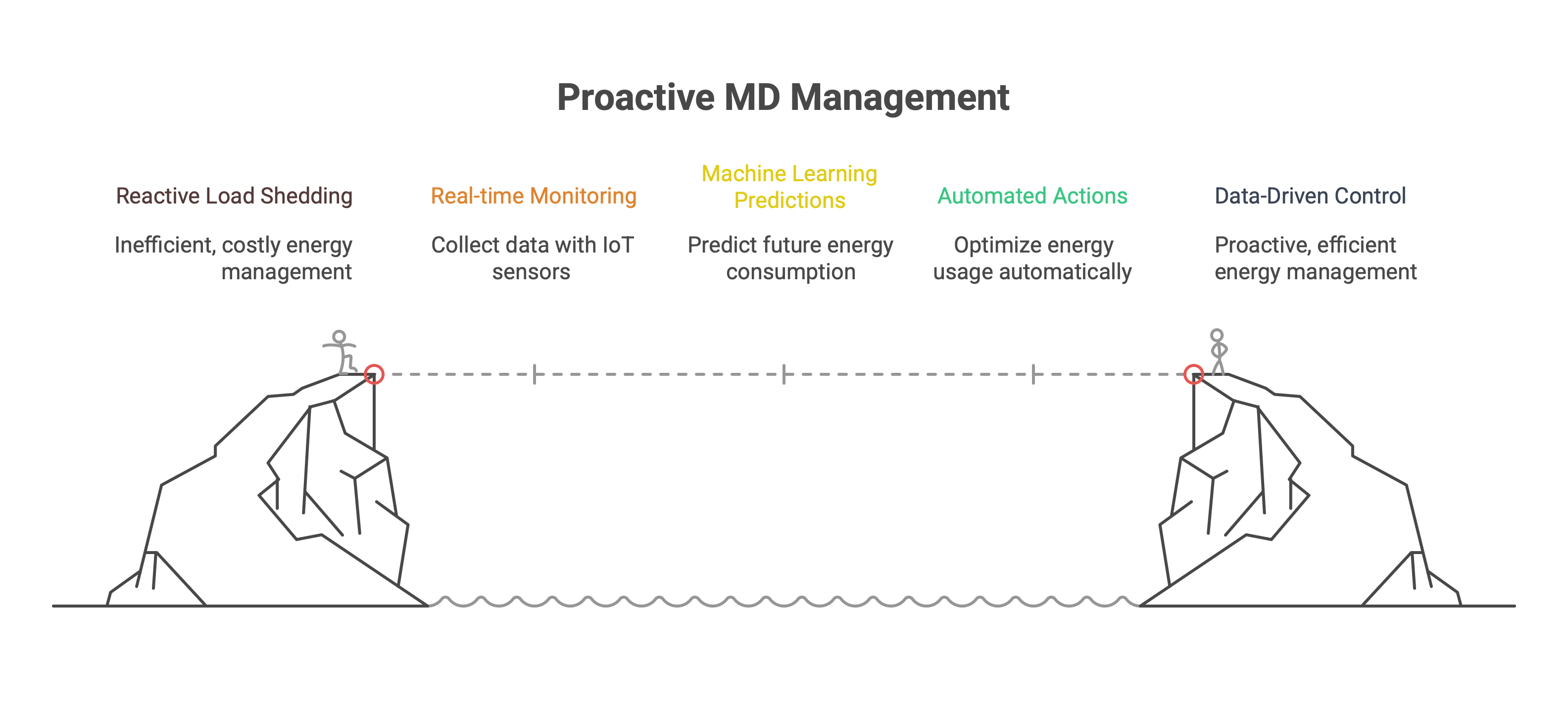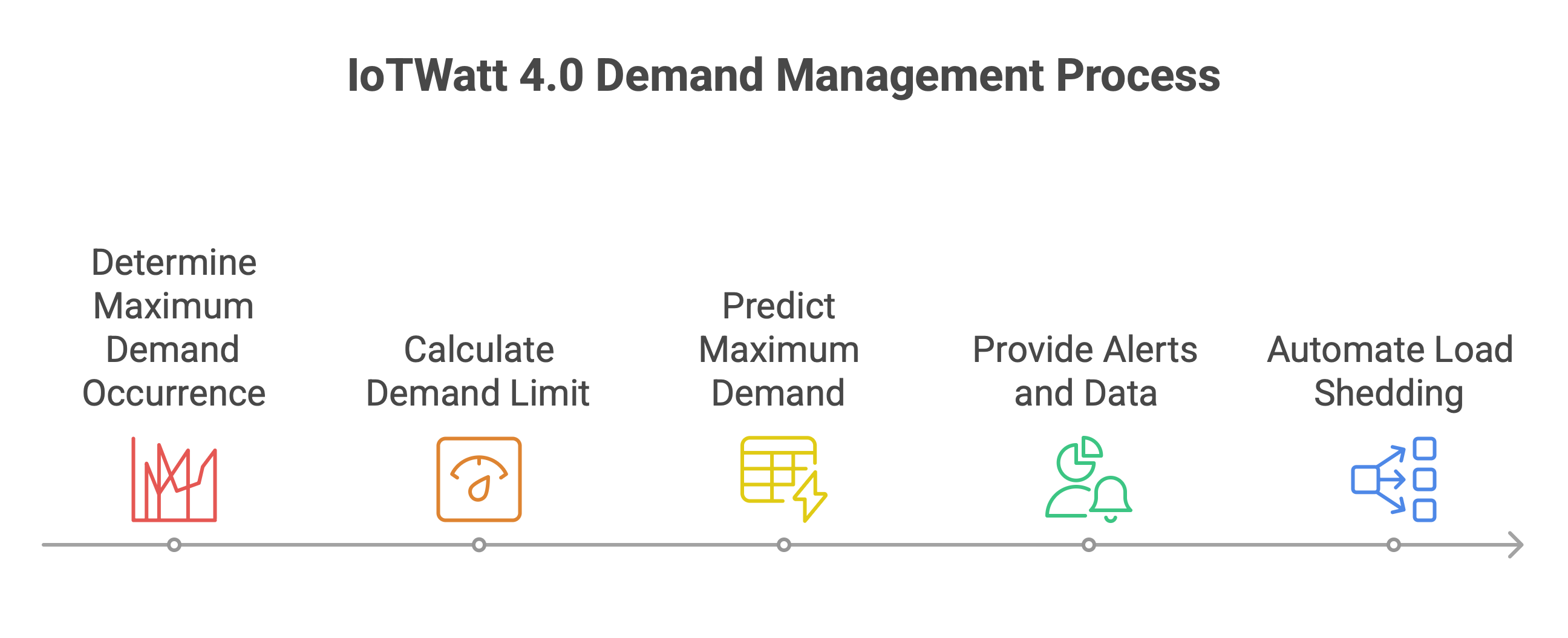It requires not only hardware like demand controllers and relays, but sophisticated analytics to predict, analyze, and act before a costly spike occurs.
This is precisely where IoTWatt 4.0 comes into play. As an advanced energy analytics and management platform delivered through Energy Efficiency-as-a-Service (EEaaS), IoTWatt 4.0 helps businesses move from reactive responses to predictive, data-driven MD control—and ensures savings without sacrificing operations or requiring any upfront investment.
Let’s explore how to control and reduce MD, and why IoTWatt 4.0 can be your best ally.
What is Maximum Demand, and Why Does It Matter?
Maximum Demand refers to the highest level of electrical power demand recorded over a specific period, often measured in kilowatts (kW) or kilovolt-amperes (kVA). Utilities typically charge industrial and commercial customers based on:
- Energy Consumption (kWh) — the total energy used
- Maximum Demand (kW or kVA) — the peak load reached
- Higher demand charges
- Penalties from your utility
- Equipment stress or grid impact

The Challenges in Managing MD
While many facilities install demand limiters to cut loads once MD approaches a preset threshold, purely reactive approaches can backfire:
- Setting limits too low leads to frequent load shedding, disrupting operations.
- Setting limits too high risks exceeding contracted demand, triggering charges and penalties.
- Relying solely on historical averages ignores real-time operational conditions.
.png)
How IoTWatt 4.0 Transforms MD Management
Modern MD management shifts from reactive load shedding to proactive, data-driven control. IoTWatt 4.0 delivers this shift by combining real-time monitoring, machine learning predictions, and automated actions.
Even better, it’s available as an EEaaS solution—meaning there’s no capital expenditure required upfront. You pay only from the savings IoTWatt 4.0 generates for you.
Let’s examine how it works.
1. Determining When Maximum Demand Occurs
IoTWatt 4.0 provides:
- Granular, real-time monitoring across circuits, processes, and equipment.
- Smart dashboards that pinpoint:
- Time-of-day trends — Is MD consistently peaking during certain shifts?
- Process triggers — Which specific equipment drives peaks?
- Seasonal impacts — Are climatic factors influencing demand?
2. Calculating the Correct Demand Limit
Choosing the right MD limit is delicate:
- Too low = constant disruption.
- Too high = unnecessary penalties.
- Operational flexibility
- Critical vs non-critical loads
- Production schedules
- Utility tariff structures and contractual limits
The platform ensures your MD limits strike the right balance between cost efficiency and operational continuity.
3. Predicting MD Before It Happens
Instead of waiting for MD to exceed limits, IoTWatt 4.0 forecasts:
- Imminent peaks based on real-time energy patterns.
- The likelihood of exceeding contractual thresholds.
- The magnitude of load reduction needed to avoid spikes.
For example:
“IoTWatt 4.0 projects MD will exceed 850 kW in 25 minutes. Recommended actions: reduce non-critical compressors and adjust HVAC load.”
This enables a measured, pre-emptive response, avoiding last-minute emergency load shedding.
4. Accurate Alerts and Actionable Data Records
IoTWatt 4.0 provides:
- Smart alerts — with precise, actionable notifications rather than generic warnings.
- Detailed data records and trends — helping you review past events, identify patterns, and refine demand strategies.
- Seamless integration — with existing EMS, SCADA, and BMS systems for coordinated responses.
5. Automated Load Shedding with Typical Load Profiles
When shedding load becomes necessary, IoTWatt 4.0 identifies typical loads to shed while minimizing impact on critical operations. These might include:
- HVAC chillers
- Non-critical compressors
- Lighting in non-essential areas
- Secondary production lines
- Shed 50 kW from chilled water systems
- Pause 30 kW from a secondary conveyor
- Dim lighting in storage zones by 10 kW
Putting It All Together
Here’s how IoTWatt 4.0 elevates MD management compared to traditional methods:
| Key Function | Traditional Approach | IoTWatt 4.0 Approach |
| Set MD Limit | Fixed, manual estimates | Data-driven, dynamic recommendations |
| Detect Peak | After it happens | Predictive alerts before peaks occur |
| Load Shedding | Reactive, disruptive | Proactive, optimized, prioritized |
| Alerts | Basic warnings | Smart, actionable, with lead time |
| Data Records | Basic logs | In-depth analytics and reports |
Benefits of IoTWatt 4.0 for MD Management
- Avoid demand penalties and costly surprises
- Stabilize operational processes and reduce disruptions
- Optimize monthly energy costs and improve ROI
- Enable proactive planning and smarter load management
- Achieve sustainability goals by reducing grid strain and peak demand
- Zero upfront costs—IoTWatt 4.0 is delivered as a fully managed EEaaS, paid only from savings achieved

Final Takeaway
Maximum Demand charges can account for a significant portion of your energy costs—but they don’t have to. With IoTWatt 4.0’s EEaaS model, you transform MD management from a reactive firefight into a strategic, predictive discipline that cuts costs, reduces risks, and improves operational resilience—all without any capital investment.
Don’t let MD spikes dictate your energy bills. Instead, predict, plan, and control—and let IoTWatt 4.0 lead the way to smarter, affordable energy management.







 BR 12048
BR 12048  US 8518
US 8518  CN 2610
CN 2610  MY 2194
MY 2194  AR 2192
AR 2192  DE 1588
DE 1588  EC 1101
EC 1101  MX 592
MX 592 

